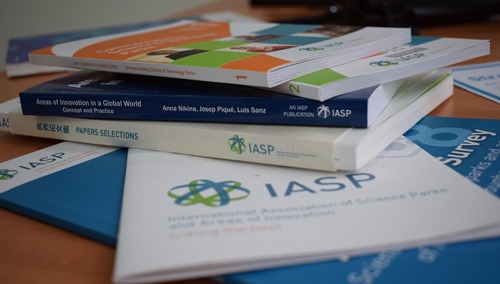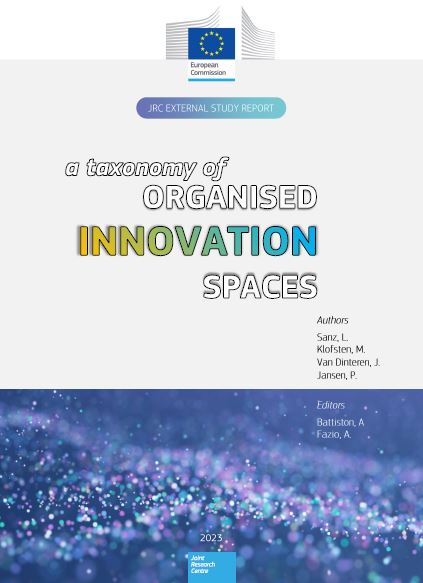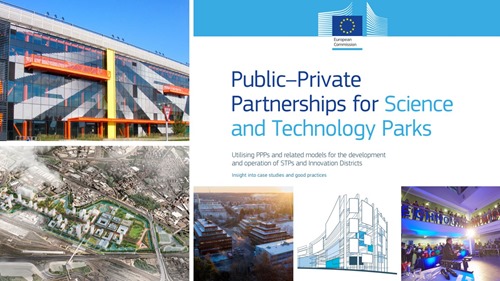Deep dive: our innovation industry in books, reports and articles
/Books_1_edit.jpg)
For more in-depth reading on science parks, areas of innovation and other innovation ecosystems, the following publications may be of interest:
Papers and studies
For a comprehensive overview of the latest trends in science parks and areas of innovation around the world, look no further than the IASP Global Survey 2022. Based on data provided by IASP members, it gives a clear analysis of the data and provides a comprehensive overview of AOIs and STPs on an international scale, as well as being an excellent platform from which to continue more in-depth study, such as:
- A "Taxonomy of Organised Innovation Spaces (OISs)", a brand new study from the Joint Research Centre (JRC), exploring the need for common terminology around innovation entities and ecosystems, as well as intermediary actors. This new term, OISs, serves as an umbrella name for science parks, areas of innovation, innovation districts, incubators, and other such innovation ecosystems. This taxonomy has been published in October 2023 and is authored by former IASP Director General Luis Sanz along with IASP Think Tank experts Magnus Klofsten and Paul Jensen, and IASP member Jacques van Dinteren.
- A 2022 study from the Joint Research Centre (JRC), the European Commission’s science and knowledge service, explores New investment models for urban innovation ecosystems with case studies from IASP members in Italy, Greece, Germany and the Netherlands.
- “Science parks as key players in entrepreneurial ecosystems" explores the crucial role of modern science parks in the creation, development, and management of entrepreneurial ecosystems. It develops a conceptual framework for analysing the role that science parks could have in developing an entrepreneurial ecosystem, interviewing several stakeholders oriented towards sustainable production.
- A 2022 study from the University of Malaga looks at the effect of science and technology parks on tenant firms. The paper provides a comprehensive and systematic review of the STP literature, focusing especially on quantitative papers aimed at assessing the park effect on tenant’s performance: read it here.
- JRC's 2019 report into Public–Private Partnerships (PPPs) for Science and Technology Parks. Made in collaboration with IASP and other experts, it includes contributions and case studies from IASP members in the UK, Sweden, Slovenia, the USA and Italy, as well as data from our wider community. The study aims to provide answers to two key questions: how to apply PPPs to the development and sustainable operation of STPs and AOIs/innovation districts, and identify the key features of currently existing PPPs. Read the full report on the JRC website.
Books about our innovation industry
Past President of the IASP Advisory Council McLean Sibanda recently published Nuts and Bolts, a look at strengthening Africa’s innovation and entrepreneurship ecosystems, where he argues that "The future of Africa is bright. Innovation, and not aid, is the answer," and offers practical insights on innovation and entrepreneurship for Africa’s development
The Handbook of Research on Business and Technology Incubation and Acceleration: A Global Perspective features a chapter from Past President Josep Piqué, who highlights how active partnerships among university, industry, and government (Triple Helix) can support the development of urban science parks as enabling incubation mechanisms for innovative startups.
And in February 2021, IASP members IADP published a new book called Areas of innovation, with insights into the latest developments in science parks and innovation districts.
In 2020, our CEO Ebba Lund contributed to Science and Technology Parks and Regional Economic Development – An International Perspective, a book developed from presentations at a 2018 workshop of the European Commission’s JRC, organised in collaboration with IASP members PCT Cartuja. Edited by Sara Amoroso (JRC), Albert N. Link (University of North Carolina at Greensboro) and Mike Wright (Imperial College Business School, London) the book explores concrete ways to systematically collect information on public and private organisations related to their support of STPs, including incubation to startups and scaleups, and collaborations with centres of knowledge creation.
The IASP chapter looks at the strategic choices that STPs must make, with reference to IASP’s Strategigram tool which enables science park managers to visualise and analyse their strategic profile. The text explores implications for park managers of the position their STP occupies, as well as considering the evolution of the STP concept in the knowledge economy, and the emergence of the new areas of innovation.
The book also includes a chapter by Soledad Diaz, manager of the Spanish Association of Science Parks (APTE), who takes a look at the growth of the activity of Spanish STPs over the last 20 years, in-depth studies on their socio-economic impact at local, regional and national levels, and the systematic data collection methodology that has made such studies possible.
It can be purchased from the publisher’s website; the Strategigram tool is available to members on our website.
IASP and our members in the media
Issue 14 of Breakthrough magazine features an interview with current IASP European Division President Salvatore Majorana and his predecessor in the role (and current IASP Vice President) Lena Miranda, exploring their perspectives on innovation and global cooperation.
The Financial Times published a series of articles in a special report on universities and education, to which IASP was pleased to contribute global data about science parks and areas of innovation. It’s an interesting look at the generation of intellectual property and how universities nurture spinouts in the UK, Turkey and California, which includes a feature on IASP member ITU ARI Teknokent, one of the hosts of IASP Istanbul in 2017, and how they are supporting startups and building an innovation ecosystem in Istanbul.
Urban renewal and the re-purposing of imposing former industrial buildings as state-of-the-art hubs of creativity and collaboration is at the heart of a long piece from the Royal Institution of Chartered Surveyers, published in their Modus magazine. Taking a close look at IASP member Here East, the article explores how the vast “groundscraper” that once housed the broadcast centre used by the world’s journalists during London's 2012 Olympic Games has been transformed into a huge innovation campus. “No one has done what we have done anywhere else in the world in the history of the modern games. The International Olympic Committee has flagged this as a case study of how you make something that is a necessity for the Games work once they are over,” said Gavin Poole, CEO of Here East.
Why not browse the IASP Knowledge Room and see the full range of books, studies and conference papers on we have available?
/)




/canvascolor(0xffffffff)/buildings2.png)
/canvascolor(0xffffffff)/2017_08_07_HHTP.png)
/canvascolor(0xffffffff)/logo_2_(para_rodape_)_1.png)
/canvascolor(0xffffffff)/New_Logo_sapiens_(1)_page-0001.jpg)
/canvascolor(0xffffffff)/2017_08_04_Eindhoven.png)
/canvascolor(0xffffffff)/2019_06_12_Taiwan_Hsinchu_SP.JPG)
/canvascolor(0xffffffff)/SSTP_Logo_New_-_02.png)
/canvascolor(0xffffffff)/logo-oscuro-parque-cientifico-ua.png.png)
/canvascolor(0xffffffff)/2017_10_31_Spain_Fundacion_Comunitat_Valencian.jpg)
/canvascolor(0xffffffff)/2019_11_12_China_Tuspark_(Jiangsu).png)
/canvascolor(0xffffffff)/MemberLogo-25804-6113.jpg)
/canvascolor(0xffffffff)/FOTO-PERFIL-2.png)
/canvascolor(0xffffffff)/TusPark_Belgium.png)
/canvascolor(0xffffffff)/Incuba.png)
/canvascolor(0xffffffff)/cc-rgb-blackFullS_2.jpg)
/canvascolor(0xffffffff)/2023_10_17_China_Weiguang_Life_Science.png)
/canvascolor(0xffffffff)/KENNISPARK-TWENTE_FC-LOGO-1-800x220_1.png)
/canvascolor(0xffffffff)/iZET_logo_3.png)
/canvascolor(0xffffffff)/2017_10_26_Portugal_Madan_Parque.jpg)
/canvascolor(0xffffffff)/Norwich_Research_Park_Logo_artwork_transparent_bg_4.png)
/canvascolor(0xffffffff)/Tech_Parks_Arizona_1.png)
/canvascolor(0xffffffff)/2020_05_07_Brazil_Porto_Digital.jpg)
/canvascolor(0xffffffff)/MemberLogo-5826-6312.jpg)
/canvascolor(0xffffffff)/Lion_scienc_park_black_trans_3.png)
/canvascolor(0xffffffff)/MemberLogo-5652-6081.jpg)
